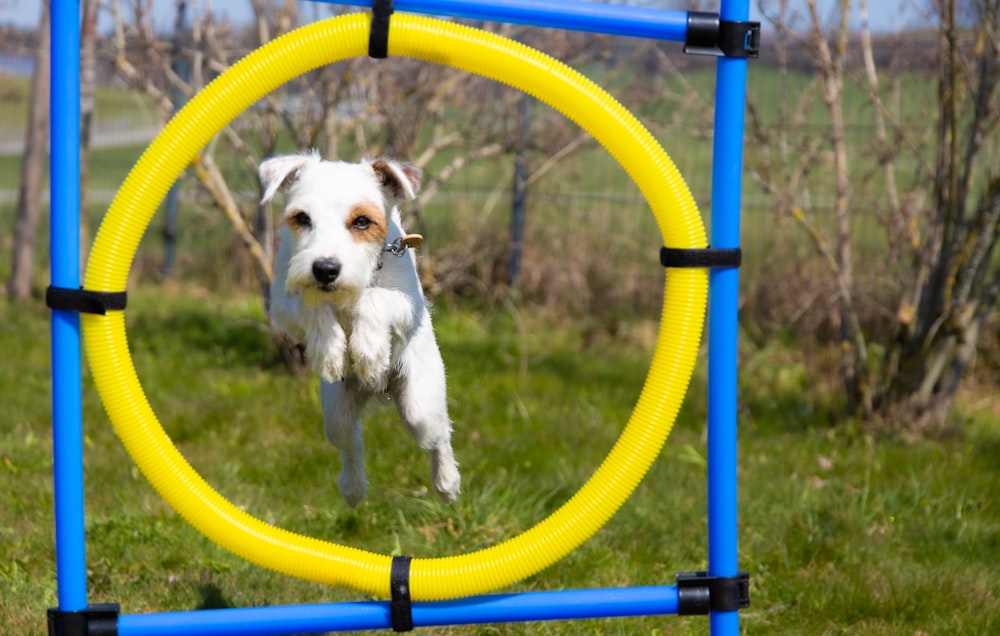Dog agility is a popular sport for dogs and their people that is growing fast. There’s a good reason, too: agility provides exercise for dogs and humans alike, deepens their bond, and provides a healthy level of competition among participants. If you’re interested in Agility, here’s what you need to get started with your dog agility training.

Understanding the Basics
Before we delve into what you need, let’s talk about what you need to know. Dog agility is a sport where you direct your dog through an obstacle course and complete the course under a specific time limit.
What Kind of Obstacles Are There In Agility?
Courses are usually between 14 and 20 obstacles long and can include:
- Tunnel
- Weave pole
- Seesaw
- “Pause” table
- Tire jump
- Dog walk
- Teeterboard
What breeds of Dog Can Participate in Agility?
One of the best parts of Agility competitions, or “trials,” is that any dog can participate. Any breed, any mutt, any size dog can get into dog agility training. The best-suited dogs for agility are ones who are energetic and respond well to your instructions. You need to be able to tell your dog where to go and what to do in the course, but your dog also has to have the drive and stamina to run through it.

Tips To Start Dog Agility Training
Before you ever enter an obstacle course, you will need to take time working on your dog’s basic behaviors and then slowly introduce them to the various aspects of agility. This is a time-consuming process, but the results are so worth it. Now that you grasp the basics, here are a few tips to start dog agility training.
Once your dog has a good grasp of the training, you can start working on the obstacles! If you don’t have access to an agility course, class, or club, you don’t necessarily have to drop hundreds of dollars on obstacles. You can make your own agility course with things you already have!
What Obstacles Are Used in Dog Agility?
When using dog agility training, you need to make sure you abide by the sport’s strict rules and regulations. These rules create a uniform sport that is played internationally. The obstacles we use in dog agility are under a specific set of sizes and regulations too.
Contact Obstacles
Every dog agility course has 3 “contact” obstacles. Contact obstacles have bright, highlighted areas that your dog’s paws must come into contact with.

Dog Walk
The dog walk obstacle is a regulated length of elevated platform with an angled ramp at each end. It is covered in anti-slip material and anti-skid slats on the ramps. The “contact area” is a bright color, clearly visible compared to the rest of the surfaces. When your dog jumps onto and off of the dog walk, their paws must come into contact with the contact areas before they jump down. This rule keeps them from jumping off of the obstacles from too great a height.

A-Frame
An A-frame is similar to a dog walk but without the elevated flat platform in the middle. A-frames are made out of two ramps hinged together in the middle, in a triangular shape. The lower part of each ramp is painted a bright color to indicate the contact area. Like the dog walk, the ramps are covered in anti-slip material and anti-slip slats.
See-Saw
See-saws, or teeterboards, are a bit more advanced than a dog walk or A-frame, primarily because they move. A see-saw is a single board attached to a center bracket. Once the dog crosses the middle of the board, the far end drops down to contact the ground. Like the other contact obstacles, the see-saw board’s ends are highlighted to indicate required contact areas.
Other Obstacles
In addition to contact obstacles, there are a variety of other agility obstacles you are likely to see in a competition.

Tire Jump
A tire jump resembles a hoop that your dog must jump through. This obstacle has a tire or other hoop-shaped object that is relatively free-swinging.

Hurdles
Hurdles are common objects in an agility obstacle course. Their height depends largely on your dog’s size and the difficulty of the course.

Weave Poles
Another popular agility obstacle is the weave poles; they are also one of the toughest to train your dog to do. Weave poles are generally set up in a straight line of 10 to 12 poles on a stable base. Your dog then has to weave through them as quickly as possible.

Pipe Tunnel
Every dog agility training course has at least one pipe tunnel. A pipe tunnel is a curved tunnel that your dog cannot see the end of. Their willingness to enter the tunnel at a full sprint signifies their bond with and trust in their handler. To navigate the pipe tunnel, the dog must follow the handler’s voice commands rather than their own eyes.
Pause Table
A pause table is an elevated surface where a dog is required to jump up and “pause.” To effectively navigate this obstacle, a dog should jump up on the table covered in non-skid material and come to a complete stop for a predetermined amount of time. Once done, the handler releases the dog, and they continue on their way through the course. The table’s size and height depend on the intensity level and breeds of dogs competing in the course.
Dog Agility Training Will Deepen Your Bond
Whether you plan on training for intense competitions or just for fun on your neighborhood course, dog agility training is a fantastic way to spend time with your dog. You both get to exercise, deepen your bond, and hone your communication skills. Not to mention the most important part: you get to have fun together!

